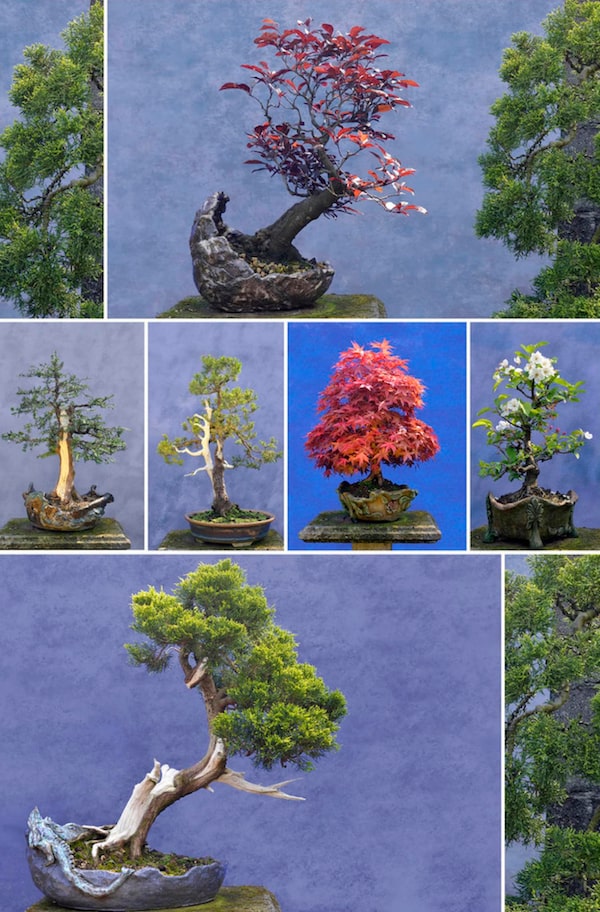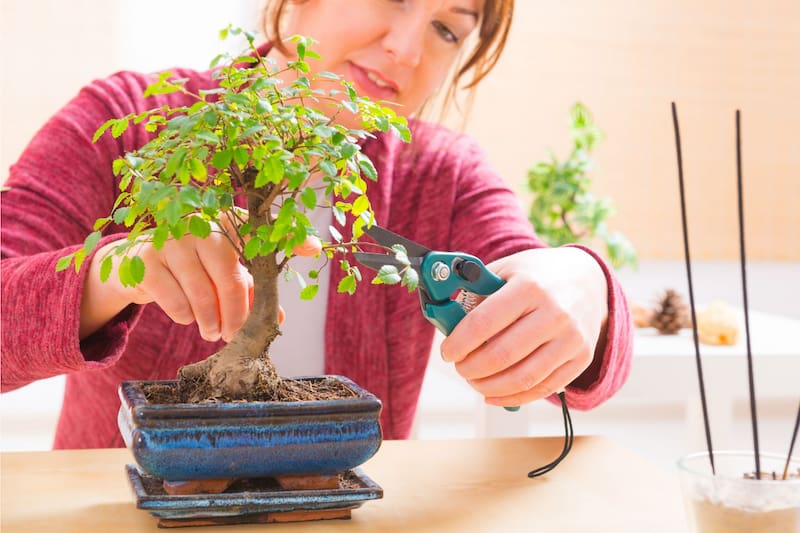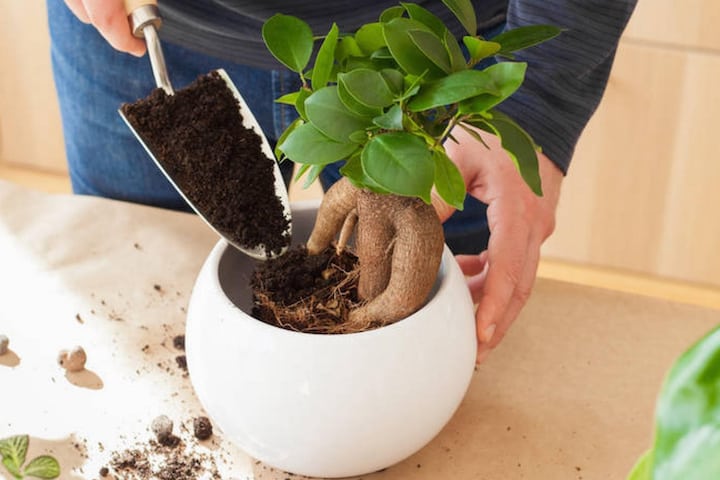If you are fascinated by the idea of growing a tree right in your living room, growing a bonsai or miniature tree may be the answer.
Bonsais have a bit of a reputation as difficult or finicky to care for and this in itself may dissuade people from taking a chance.
But with some understanding on how to grow bonsai trees, you’ll be able to enjoy their serene beauty.
Let’s get into how to grow a bonsai tree.
Grow Bonsai Trees Overview
For those of you that perhaps think of a “bonsai” as a species of tree, it is not.
“Bonsai” refers to the methodology applied to shaping a tree artistically. These techniques can be used on a multitude of different species of trees.
Not all species will necessarily be adaptable to becoming bonsai trees. Some will be easier than others. Different bonsai tree species will also grow at different rates.
Learn more about Bonsai Growth Timelines.
The art of bonsai also includes several styles, among them:
- Formal
- Informal
- Slanted
These style definitions generally refer to the stature of the tree and its natural shape. Both stature and shaping can be manipulated through pruning and wiring.
Learn more in this Bonsai Tree Size Guide.
Also see our beginner’s guide to cultivating bonsai trees:
Bonsai Tree Varieties
The kind of tree you select for your bonsai will depend on the climate where you reside and where you will position your bonsai tree. Do you plan on cultivating an indoor bonsai or planting a bonsai tree outdoors?
Not all species will do well indoors, because temperatures don’t change much, and it is less humid than outside.
Bonsai trees, like regular outdoor full-sized trees, do better when there are four seasons that include a period of dormancy that occurs in the winter.
However, some bonsai tree varieties thrive indoors:
- Hawaiian Dwarf Umbrella Tree
- Ficus Nerifolia
- Ficus Retusa
- Jade Plant / Jade Tree
If you have a yard, outdoor garden, or space, you will have more choices. These may include:
- Boxwood
- Cotoneaster
- Deciduous species (meaning their leaves change with seasonal change, for example, elms, ginkgo, or maple)
- Junipers
- Pine
- Spruce
Every species will have its own specific requirements, so it is wise to research bonsai tree species to get information for the correct type of care for your bonsai.
Learn more about the most popular bonsai tree species.

Bonsai Technique and Care
Here are some general concepts to help your bonsai tree thrive in your care. Bonsai trees can live for hundreds of years with proper care and maintenance.
Care tips that are applicable to most types of bonsai trees include:
- Stay Humid and Moist – These miniature trees do need some humidity to help keep their soil moist or damp
- Lots of Light – Bonsais, like all trees, need lots of light, so place your bonsai where it will have access to bright indirect light.
- Avoid Extreme Temperatures – Bonsais need to avoid drafts. They should be kept away from vents, air conditioning, or direct heat of any kind.
Soil and Water for Bonsai Trees
While this may seem obvious, correct watering can make all the difference in the success of caring for your Bonsai. Like with all houseplants, the most common causes of illness and death are underwatering or overwatering.
A well-draining Bonsai soil mix is needed for your Bonsai to grow healthy. Learn more in this Bonsai Soil Guide.
Your bonsai needs to be monitored carefully. Avoid watering your tree on a regular schedule. It’s better monitor it on a daily or every other day basis, and water as needed.
The amount of water and how often to water will depend on different factors:
- Species of the tree
- Climate and Temperature where you reside
- Type of pot or container
- general health of the tree
It is a good rule of thumb to not let the Bonsai’s soil bed dry out completely as these miniature trees also have miniature root systems. If the soil bed dries out completely, roots may follow and die as a result.
Bonsais should be watered while the soil is still a bit damp. You will need to monitor, because most bonsai trees are planted in containers that are relatively shallow, meaning that the soil bed will dry out faster.
To ensure the proper saturation of the root system, make sure the container has drainage holes. Water until it runs out of these holes. It is a good idea to place a tray under your bonsai container to allow excess water to collect in the tray. Then toss the excess water.
Should you overwater, your tree will indicate this by the leaves yellowing or the shriveling of small branches. The bonsai tree leaves will start falling as well.
Overwatering means you are drowning the roots of your tree and they no longer receive adequate oxygen. A poor draining soil bed can contribute to this condition.
Pruning Bonsai Trees

Pruning can be described as the key to your art or keeping your tree in its miniature version. For bonsais cultivated as indoor plants, there is no specific rule of when or in which season you need to prune.
An outdoor bonsai should be trimmed back during the growing season, and this means in the spring and summer months.
When you do begin to prune, cut back any twigs that grow three or four nodes or joints. Also, remove any crossed branches or any broken branches from your tree.
Pruning is not used only to keep your tree in its miniature form, but also to shape it to your aesthetic tastes.
Read about the best bonsai scissors for pruning.
If your tree grows a couple of inches, it can be trimmed back at any time. Remove any branches or growth at the base of the tree. Also, trim away any branches that may grow in a wrong or untoward direction.
To remove foliage when shaping, use a small pair of scissors or pinch off leaves. If you need to cut back branches, it is better to use concave cutters for gardening.
Correct cutting or trimming will leave an almost smooth surface and facilitate the healing of the wound. In general, do not prune more than one-third of the tree’s foliage at a time.
Fertilizer for Bonsai Trees
If your bonsai has not reached the size you desire, it should be placed on a schedule for feeding. A fully-grown, mature bonsai will require occasional fertilization.
Both mineral and organic fertilizers can be used. A dose of a balanced liquid fertilizer bi-weekly is ideal.
Learn more about the Best Fertilizers for Bonsai Trees.
Bonsai Wiring
While most beginners shape their bonsai by pruning it, experienced bonsai artists also use wiring together with pruning. Bonsai wiring is the method used to move the bonsai’s branches in one direction or another to help with the shaping of the tree.
When wiring, a bonsai artist will wrap a branch of the tree with wire and then position the branch thanks to the wire in a desired direction of the shape. This helps the branch to grow in a specific direction.
To attempt wiring, beginners can start by using anodized aluminum wire. If you are worried about damaging the branches you wish to bend or redirect, wrap them in raffia fiber that has been soaked, before applying the wire.
Repotting a Bonsai
One might think that a Bonsai doesn’t necessarily require repotting, but it does. Apart from giving your tree a new soil bed on occasion, it also provides the opportunity to trim the root system of your bonsai.
Bonsais should be repotted every second year as a general rule. An older, mature bonsai may be repotted every third year.

The quickest way to tell if your bonsai needs repotting is to look at its root system. If it begins to circle the container, it will need to be trimmed back.
Repotting is ideally done in the springtime before the growing season takes off.
When you do remove your bonsai from its pot, gently remove any old soil from the root system. This can be done with a wooden chopstick, popsicle stick, or similar.
Trim the root ball especially if you notice that some roots have grown in length and are long. Never remove more than one-third of the root ball when trimming.
A new soil bed can now be added. You can use bonsai soil. This soil mix will normally include some organic potting compost with fine gravel, pumice, akadama, and lava rock mixed in.
Here are the steps on how to repot a bonsai:
- Remove your bonsai from its container
- Remove excess soil
- Trim the outermost layer of roots
- Check for root rot, and trim away if found
- Clean your bonsai’s container thoroughly
- It is a good idea to cover the drainage holes with small pieces of mesh wiring to prevent losing soil
- Place a layer of soil in the container and set the tree on top of it
- Fill in the container with your soil mix
Bonsai Educational Resources
If you are new to cultivating bonsai trees, it may be worth your while to search for a class or workshop in your area. Check to see if your local area has a Bonsai Society or association.
There are many great bonsai books too. See my list of the Best Bonsai Books.
Meeting and working with experienced bonsai artists will assist you, if you have any doubts about the best care for your tree.
If your area is not home to a group of local bonsai enthusiasts, there are quite a few resources available online with some great videos to help you get started too. Here’s a great video of a Bonsai demonstration with a chainsaw:
Growing Bonsai Trees Final Thoughts
Ready for your first attempt at the art of the bonsai?
This is a very satisfying expression of green art that will provide you great pleasure. Not only will you be able to work with Mother Nature to shape your miniature tree, but you will have a lovely addition to your home or office decor.
For more growing guides, check out these houseplant articles:
- Are Bonsai Trees Poisonous to Cats?
- Bird’s Nest Fern Care Guide
- Areca Palm Care Guide
- Arrowhead Plant Care Guide
- Chinese Evergreen Care Guide
How to Make Bonsai Trees FAQs
How long does it take to grow a bonsai tree?
The time required for a bonsai tree to grow depends upon many factors including climate, location, size, species, etc. It could take anywhere between two months to several years depending on all these variables. If you want to grow a bonsai tree from seed, it can take up to 5 years to become a mature tree.
Can you make any tree a bonsai?
Yes! There are hundreds of different types of plants which can be made into bonsais. Any perennial tree that produces branches and can be kept small while cultivating can be made into a bonsai.
Which is the best bonsai tree for beginners?
There are so many varieties of bonsai trees out there that choosing just one would be difficult. However, I recommend starting with the dwarf Japanese Maple. They are easy to maintain and produce beautiful foliage throughout their life. They also come in a wide variety of colors and sizes making them perfect for beginner gardeners who don’t know much about gardening yet.
Why do bonsai trees grow so slow?
There are a couple main reasons why bonsai trees grow so slow. One reason is because they’re grown in a container, so the pot limits their growth potential. Another reason is because they’re often cultivated indoors under artificial conditions. The lack of sunlight causes the plant’s growth rate to decrease.
Why are bonsai trees expensive?
Bonsai trees can be expensive because they’re more works of art, rather than just a houseplant. The care and techniques used to grow and make bonsai trees can take years to master. The bonsai pots and tools that are used are usually handmade, costing up to thousands of dollars.
How to grow a bonsai tree from a cutting?
A good way to start growing a bonsai tree is by taking cuttings from an established bonsai tree. This method requires patience as well as skill. You’ll need to carefully remove the leaves from the branch where you’d like to propagate the new shoot. Then place this leafless section in potting soil in a container. Keep watering regularly and watch over the young shoots closely. They will start growing in a few weeks.







